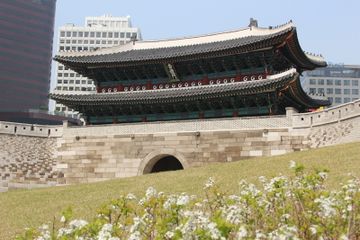서울 숭례문
| 서울 숭례문 Sungnyemun Gate, Seoul |
|
 서울 숭례문, 국가문화유산포털, 문화재청. |
|
| 대표명칭 | 서울 숭례문 |
|---|---|
| 영문명칭 | Sungnyemun Gate, Seoul |
| 한자 | 서울 崇禮門 |
| 주소 | 서울특별시 중구 세종대로 40 (남대문로4가) |
| 지정(등록) 종목 | 국보 제1호 |
| 지정(등록)일 | 1962년 12월 20일 |
| 분류 | 유적건조물/정치국방/성/성곽시설 |
| 시대 | 조선시대 |
| 수량/면적 | 1동 |
| 웹사이트 | 서울 숭례문, 국가문화유산포털, 문화재청. |
|
|
|
해설문
국문
숭례문은 조선 태조 7년(1398)에 한양도성의 남쪽 대문으로 세워졌다. 그 후 세종 30년(1448), 성종 10년(1479), 고종 연간에 큰 수리가 있었다. 조선시대에는 매일 밤 인정(10시 무렵)에 문을 닫았다가 다음 날 아침 파루(4시 무렵)에 문을 열었는데, 이때 문루에 종을 달아 그 시간을 알렸다. 장마나 가뭄이 심할 때는 임금이 몸소 기청제와 기우제를 지내는 등 숭례문에서는 국가의 중요한 행사가 거행되곤 하였다.
석축 위에 세워진 중층 누각은 장식이 간결하고 내부 구조가 견실하여 조선 초기의 건축기법을 잘 간직하고 있다. 1907년부터 1908년 사이에는 좌우 성곽이 철거되었으며, 한국전쟁 때 피해를 입어 1961년부터 1963년 사이에 해체보수를 하였다. 2008년 2월 10일 방화 사건으로 크게 훼손되어 2013년 4월까지 복구하였으며, 이때 좌우 성곽도 함께 복원하였다.
영문
- Sungnyemun Gate, Seoul
기존 영문
Sungnyemun, the South gate of Seoul, was elected in 1398. 7th year of King Taejo. founder of the Joseon Dynasty, as one of the four gates of the capital city. Major repairs were done on the gate in 1448, the 30th year of King Sejong the Great, in 1479, the 10th year of King Seongjong, and during the reign of King Gojong(reg. 1863~1907), the second to the last king of Joseon. During the Joseon period, the gate was closed around 10 p.m. and opened around 4 a.m., at which times the bell installed in the gate house tolled to proclaim the closing and the opening of the gate. At times of flood and drought the king came to the gate to preside over prayer rituals invoking fair weather and rainfall, respectively.
The two-story gate house erected atop the gate wall has sturdy internal structure and beautifully decorated early Joseon-style bracket system. Between 1907 and 1908, the city walls to the left and right of the gate were torn down by the Japanese, who had made Korea their protectorate in 1905 and exercised practically sovereign power.
The gate was damaged during the Korean War(1950~53), so from 1961 to 1963, it was taken completely apart, thoroughly repaired, and fully reassembled. In February 2008, an arsonist set fire to the gate, almost entirely destroying the roof of the gate house, to the nation's great horror. Repair was planned and carried out for five years, from 2008 to 2013, during which the city walls to the right and left of the gate were also restored.
새로운 영문
This gate was the main gate of the Seoul City Wall, the stone fortress that encircled Hanyang, the capital of the Joseon dynasty (1392-1910). Its name Sungnyemun means "Gate of Exalted Ritual," though it is more commonly known by its nickname Namdaemun, meaning "Great South Gate."
The Seoul City Wall, measuring 18.6 km in circumference, was built along the ridges of four mountains in the north, south, east, and west of the capital, namely Baekaksan, Namsan, Naksan, and Inwangsan. It protected the kingdom's most important institutions, including the royal palaces, royal shrine, and central government offices. The fortress had four major gates, one each in the four cardinal directions, as well as four minor gates located between them, which facilitated access into and out of the walled city.
As the main gate of the fortress, Sungnyemun held a bell which was rung twice a day to announce the closing and opening of the walled city at 4 a.m. and 10 p.m. each day. The gate was also visited occasionally by the king, who presided over rituals held here during times of flood and drought.
The gate was first built in 1398 and was renovated in 1448 and 1479. From 1907 to 1908, just prior to Japan's colonization of Korea (1910-1945), the walls to either side of the gate were demolished by Japanese authorites to make way for roads. The gate was damaged during the Korean War (1950-1953), and from 1961 to 1963, it was disassembled, thoroughly repaired, and reassembled. In 2008, most of the gate's wooden pavilion was destroyed in an arson attack. It was rebuilt from 2008 to 2013. At this time, the stone walls to either side of the gate were also extended to better show how they would have originally looked.
The structure consists of a stone base with an arched passageway and a two-story wooden pavilion that served as a lookout tower. Stone gates such as this one are known in Korean as hongnyemun, meaning "rainbow gates," as the arched passageway is shaped like a rainbow. The pavilion has a two-tiered tile roof with a hip-and-gable shape that was reserved only for buildings of great significance. The colorful decorative painting and the bracket structures below the roof are also markers of the building's high status. A unique feature of the gate is its hanging name plaque, which is oriented vertically rather than horizontally, as is custom. This is said to have been done to mitigate the firey feng shui energy of Gwanaksan Mountain, located on the other side of the Hangang River.
- 고종 때 수리 된 것을 다시 확인할 필요가 있어요.
- 문단 순서에 대해 아직 고민 중이에요~ 이대로하면 뭔가 마무리 되는 느낌이 없어서 걱정이에요.